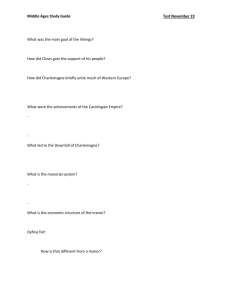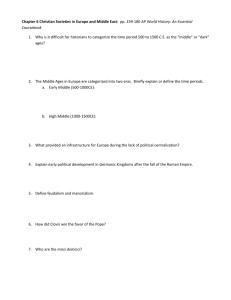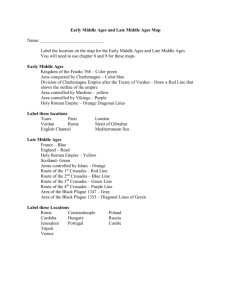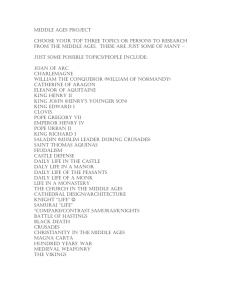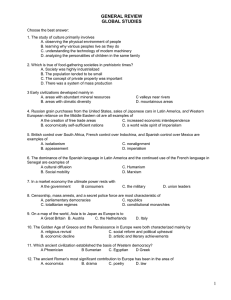Middle Ages
advertisement
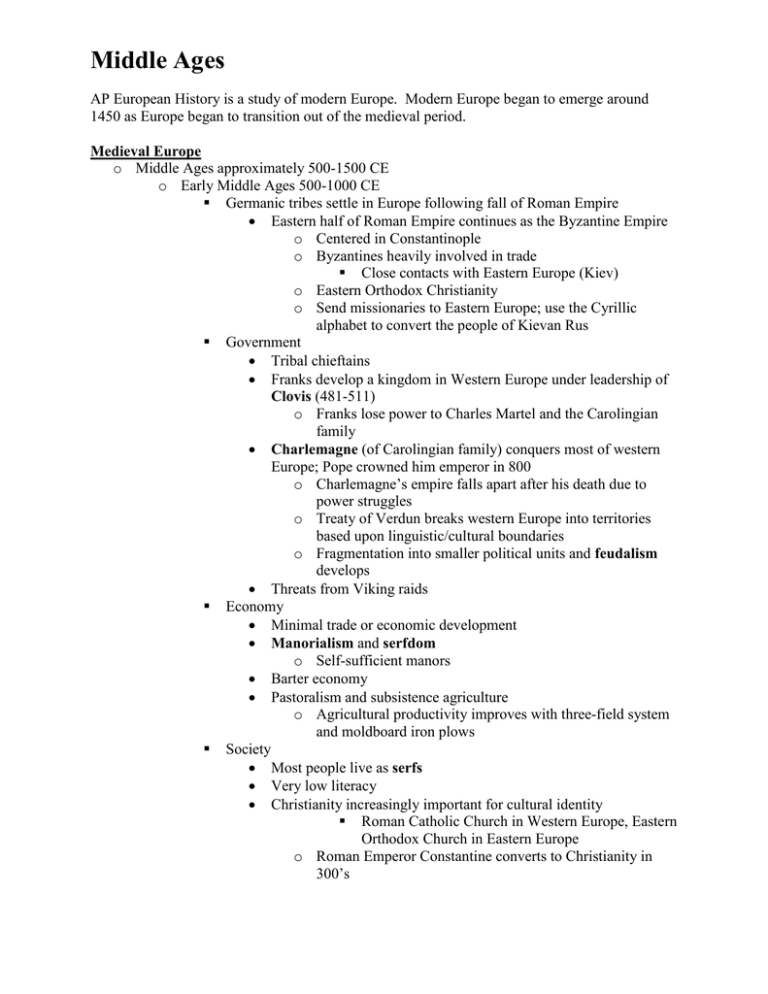
Middle Ages AP European History is a study of modern Europe. Modern Europe began to emerge around 1450 as Europe began to transition out of the medieval period. Medieval Europe o Middle Ages approximately 500-1500 CE o Early Middle Ages 500-1000 CE Germanic tribes settle in Europe following fall of Roman Empire Eastern half of Roman Empire continues as the Byzantine Empire o Centered in Constantinople o Byzantines heavily involved in trade Close contacts with Eastern Europe (Kiev) o Eastern Orthodox Christianity o Send missionaries to Eastern Europe; use the Cyrillic alphabet to convert the people of Kievan Rus Government Tribal chieftains Franks develop a kingdom in Western Europe under leadership of Clovis (481-511) o Franks lose power to Charles Martel and the Carolingian family Charlemagne (of Carolingian family) conquers most of western Europe; Pope crowned him emperor in 800 o Charlemagne’s empire falls apart after his death due to power struggles o Treaty of Verdun breaks western Europe into territories based upon linguistic/cultural boundaries o Fragmentation into smaller political units and feudalism develops Threats from Viking raids Economy Minimal trade or economic development Manorialism and serfdom o Self-sufficient manors Barter economy Pastoralism and subsistence agriculture o Agricultural productivity improves with three-field system and moldboard iron plows Society Most people live as serfs Very low literacy Christianity increasingly important for cultural identity Roman Catholic Church in Western Europe, Eastern Orthodox Church in Eastern Europe o Roman Emperor Constantine converts to Christianity in 300’s Middle Ages o Missionaries travel throughout Europe and form monasteries o High Middle Ages 1000-1500 CE Government Feudalism begins losing power in favor of more centralized government Catholic Church increased role in governance causes conflict with secular rulers/monarchs o Canon law: Church laws for behavior o Pope crowns the Holy Roman Emperor France, England, Spain begin to centralize Ideas of limited government begin in England o Magna Carta (1215) o Parliaments created to represent nobles and clergy Conflict among feudal kingdoms result in warfare o William of Normandy (William the Conqueror) invades England in 1066 Battle of Hastings o Hundred Years’ War England vs. France Hostility with Muslims o Moors in Spain and Portugal, Muslim converts in Eastern Europe o Competition for trade o Muslim threats against Byzantines in Constantinople o Crusades 1095: Pope Urban II calls First Crusade Temporarily gain Jerusalem, lose it to Saladin Other Crusades called over next couple hundred years, no permanent success Major impact due to interaction with other civilizations and technologies Economic Developments Italians (Venice and Genoa) increase trade and gain wealth from Crusades and interaction with Holy Land o Banking emerges o Trade increases Hanseatic League o Trade organization in Northern Germany and Southern Scandinavia Guilds o Association of craftsmen that control a certain trade Merchant class grows in prestige and power, often clash with landed aristocracy Catholic Church bans practice of usury Middle Ages o Jews become money lenders, leads to increased antiSemitism o Church eventually relaxes restrictions and seek patronage from wealthy merchants Catholic Church accumulates land and wealth Society Religious zeal leads to increased missionary activity o Conflict with other religions Crusades Anti-Semitism Jews secluded (ghettos) Violence (pogrom) Expelled from countries Many Jews flee to Eastern Europe Society becomes increasingly male dominated Black Death Intellectual developments o Universities created (largely to educate the clergy) o Knowledge gained from Crusades o Scholasticism: attempts to incorporate Christian teachings and Greek philosophy and logic Thomas Aquinas Vernacular literature begins in 13th century o Dante, Chaucer Gothic Cathedrals

